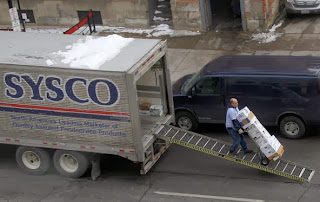Recently a
financial advisor called me to discuss investments and, more specifically, Sysco’s
acquisition of U.S. Foods. I had to read
up on what he was talking about.
The Sysco deal
is a reverse triangular merger. It is not hard to understand, although the
terms the tax attorneys and CPAs throw around can be intimidating. Let’s use an
example with an acquiring company (let’s call it Big) and a target company (let’s
call it Small).
·
Big
creates a subsidiary (Less Big).
·
Less
Big merges into Small.
·
Less
Big ceases to exist after the merger.
·
Small
survives.
·
Big
now owns Small.
Voila!
This merger is
addressed in the tax Code under Section 368, and the reverse triangular is
technically a Section 368(a)(2)(E) merger. Publicly traded companies use
Section 368 mergers extensively to mitigate the tax consequences to the companies
and to both shareholder groups.
In an all-stock
deal, for example, the shareholders of Small receive stock in Big. Granted, they
do not receive cash, but then again they do not have tax to pay. They control
the tax consequence by deciding whether or not to receive cash (up to a point).
Sysco used $3 billion of its stock to acquire U.S.
Foods. It also used $500 million in cash.
And therein
is the problem with the Section 368 mergers.
It has to do
with the cash. Accountants and lawyers call it the “basis” issue. Let’s say
that Sysco had acquired U.S. Foods solely for stock. Sysco would acquire U.S.
Foods' “basis” in its depreciable assets (think equipment), amortizable assets
(think patents) and so on. In short, Sysco would take over the tax deductions
that U.S. Foods would have had if Sysco had left it alone.
Now add half
a billion dollars.
Sysco still has the tax deductions that U.S. Foods
would have had.
To phrase it
differently, Sysco has no more tax deductions than it would have had had it not
spent the $500 million.
Then why
spend the money? Well… to close the deal, of course. Someone in the deal wanted
to cash-out, and Sysco provided the means for them to do so. Without that
means, there may have been no deal.
Still,
spending $500 million and getting no tax-bang-for-the-buck bothers many, if not
most, tax advisors.
Let’s say
you and I were considering a similar deal. We would likely talk about a double
dummy transaction.
The double
dummy takes place away from Section 368. We instead are travelling to Section
351, normally considered the Code section for incorporations.
Let’s go
back to Big and Small.
·
Big
and Small together create a new holding company.
·
The
holding company will in turn create two new subsidiaries.
·
Big
will merge into one of the subsidiaries.
·
Small
will merge into the other subsidiary.
In the end,
the holding company will own both Big and Small.
How did
Small shareholders get their money? When Big and Small created the new holding company,
Small shareholders exchanged their shares for new holding company shares as
well as cash. Was the cash taxable to them? You bet, but it would have been taxable
under a Section 368 merger anyway. The difference is that – under Section 362 –
the holding company increases its basis by any gain recognized by the Small
shareholders.
And that is
how we solve our basis problem.
The double
dummy solves other problems. In a publicly traded environment, for example, a
Section 368 merger has to include at least 40% stock in order to meet the
continuity-of-interest requirement. That 40% could potentially dilute earnings
per share beyond an acceptable level, thereby scuttling the deal. Since a
double dummy operates under Section 351 rather than Section 368, the advisor
can ignore the 40% requirement.
The double
dummy creates a permanent holding company, though. There are tax advisors who
simply do not like holding companies.
Sysco
included $500 million cash in a Section 368 deal. Assuming a combined federal
and state tax rate of 40%, that mix cost Sysco $200 million in taxes. We cannot
speak for the financial “synergies” of the deal, but we now know a little more
about its tax implications.
